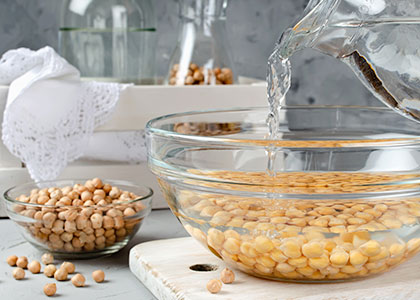
Reclaim Your Grains (By Soaking & Sprouting Them)
By Claire Georgiou, Reboot Naturopath, B.HSc ND
Soaking, sprouting and even fermenting your grains can help improve the nutrient bioavailability and assimilation, making them easier to digest.
Traditionally, people would soak, sprout and ferment grains to get the most out of them, but unfortunately we are now eating a lot of these foods without these traditional cooking and prepping methods in the name of convenience.
We now use fast-acting yeasts rather than sourdough and we use raw grains that are milled into a flour then baked, skipping the soaking step entirely. Grains can be a good source of vitamins, minerals and fiber, when prepared well.
Plants contain anti-nutrients such as phytic acid, gluten, lectins, enzyme inhibitors and other compounds which are there to ensure their own survival. The hard outer shell and the anti-nutrients inhibit digestion so they can make it through the digestive tract in-tact out to the other side to be seeded somewhere else for the survival of their own species. It’s an easy way to spread their seed and we are their pre-fertilizer.
Better Nutrient Absorption
By soaking grains you can reduce and help to deactivate these anti-nutrient compounds and improve their digestibility. Most anti-nutrients are water soluble and found in the skin, so by soaking and sprouting these foods you are essentially making these anti-nutrients inactive by up to 50%.
To soak your grains, you should place them in a bowl, cover them with hot or cold water and let them rest at least 8-48 hours. You can also add a little lemon juice or apple cider vinegar to maximize the benefits.
For baking, you can mix flour with the recommend fluids and leave to sit overnight before baking and cooking to enhance the nutrient absorption.
Sprouting has been shown to reduce phytates by up to 37-81% in various types of grains and legumes. Sprouting involves soaking and rinsing then leaving the grains in a container that allows the grains to start to germinate and sprout.
To sprout grains, start by rinsing them, uncooked. Then, pour them into a jar and cover with about 2 to 3 inches of water. Next, cover the jar with a clean kitchen towel or cheesecloth. You want them to be able to breath and keep bugs out. Let the grains soak for 24 hours, ideally in a cupboard or closet. After that, drain the grains and rinse them well, then add them back to the jar.
Rinse the grains two times a day until they sprout, about 2 to 3 days. You will know they are ready when you see the tails “sprouting” on them. Once they are ready, use them in any recipe you like.
Note: The temperature inside your home will determine how long it will take to sprout grains. Warmer homes equal a shorter sprout time, but you expect it to take at least a few days.
You can also sprout beans, seeds and nuts using this same method.
Fermentation is another traditional method originally used to preserve food. It is a natural process that occurs when microorganisms, such as bacteria or yeast, start digesting carbohydrates in food. Sourdough is a good example of grain fermentation to improve its mineral and vitamin absorption and to reduce the anti-nutrients that are naturally present.
In various grains and legumes, fermentation effectively degrades phytate and lectins.
Boiling is another method that will help to deactivate anti-nutrients particularly at high heat. High heat boiling can degrade anti-nutrients like lectins, tannins and protease inhibitors as well as calcium oxalates while phytates are heat resistant. Some people have better success digesting grains by cooking them in a pressure cooker.
By combining some of these methods altogether it will have a compound effect on reducing anti-nutrients and further enhancing the nutrient digestibility while reducing any possible gastrointestinal symptoms.
For example, the most basic method of preparing grains is prolonged soaking in water, followed by cooking to improve its digestibility. All these methods won’t take out all the anti-nutrient compounds so for people who have a compromised GIT, and the symptoms may still persist and some grains, or all in some situations, may need to be avoided.
It is important to mention the type of grain, using organic, ancient heritage grain and non-hybridized versions that aren’t heavily sprayed are also more ideal for maximum health benefits.
People with compromised guts and digestive systems really need to be mindful that these methods can really help to reduce any reactions they may experience from naturally occurring anti-nutrients in grains, legumes, nuts and seeds.
Symptoms may include bloating, flatulence, abdominal pain or cramps, headaches, allergies, sinus reactions and skin flare-ups. In some cases avoiding these foods entirely may be needed to calm the reactions down and this is where a Reboot can be helpful as you only consume fruits and vegetables for a period of time, while you are avoiding the more complex foods that require a more robust digestive system.